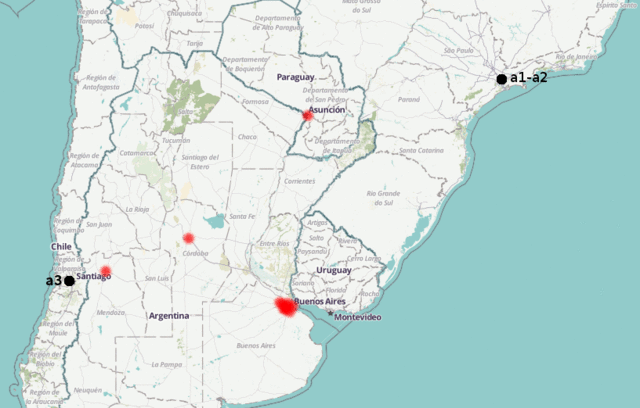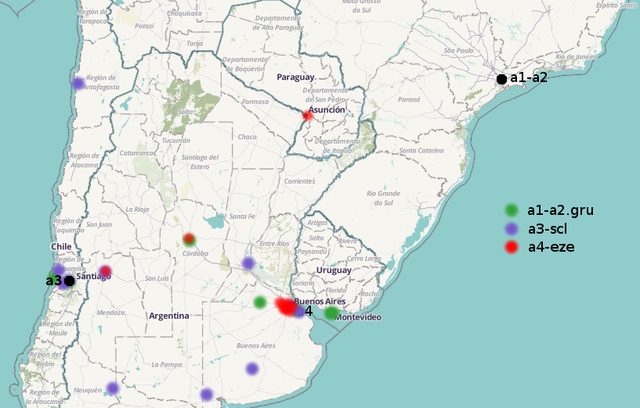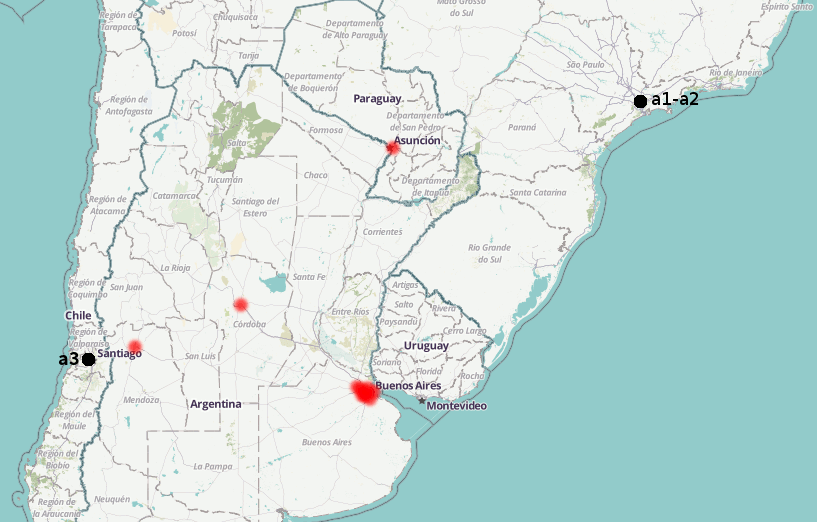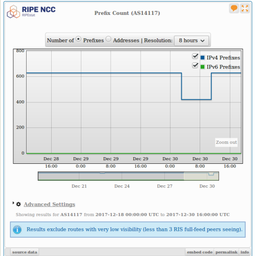Despite the few RIPE Atlas probes available in Latin America, it is possible to obtain interesting measurements about changes in network architecture.
An example of this is the recent addition of an extra node to the LACTLD anycast cloud , the organisation that groups the top level domain names in our region. This cloud answers queries directed to its name “a.lactld.org” using the nearest node, from a pool of four nodes so far. The first 2 are located in Sao Paulo, Brazil (a1-gru and a2-gru); and the third one in Santiago de Chile (a3-scl). In late June, a fourth node was added in Buenos Aires, Argentina (a4-eze); which represented a great opportunity to make an analysis of the effect it has in terms of the anycast routing technology.
The anycast technology uses the Internet routing preferences to reach the nearest node of a cloud (topologically speaking). By doing so, there is a distribution of query load and an optimisation of response times.
For this, a measurement was performed some days before the activation of a4-eze using probes from the “ RIPE Atlas ” platform. For this study we used available probes in the nearby countries of the new node: Argentina, Bolivia, Chile, Paraguay and Uruguay. From each probe we recorded the a.lactld.org cloud node that was reached, in addition to the time it took for the resolution. 56 observation points were obtained.
Figure 1 below shows both moments, before and after activating a4-eze. Marked in red are those probes that changed their preference.

Figure 1: The Animation shows both moments, before and after activating a4-eze. Marked in red are those probes that changed their preference. Bullets indicate the nodes.
Once the new node a4-eze was activated we repeated the same measurement. The results showed that 10 of them changed the node preference to Buenos Aires. Those were the ones affected by the new advertised route. All these probes showed significant improvements in response times, between 16% and more than 80% in 4 nodes. Argentina and Paraguay probes had the most benefits. This can be seen in the table below.
| City | Pre a4 Node | Pre a4 Time | Post a4 Node | Post a4 Time | Delta | Improved (%) |
| Buenos Aires | a1-gru | 100.139 | a4-eze | 74.210 | 25.929 | 25.90 |
| Buenos Aires | a3-scl | 159.333 | a4-eze | 3.014 | 156.319 | 98.08 |
| Buenos Aires | a3-scl | 212.462 | a4-eze | 33.374 | 179.088 | 84.30 |
| Córdoba | a3-scl | 177.031 | a4-eze | 17.956 | 159.075 | 89.86 |
| Asunción | a3-scl | 187.395 | a4-eze | 156.668 | 30.727 | 16.40 |
| Buenos Aires | a3-scl | 210.249 | a4-eze | 32.018 | 178.231 | 84.78 |
| Buenos Aires | - | - | a4-eze | 21.581 | - | - |
| Buenos Aires | a1-gru | 102.249 | a4-eze | 75.597 | 26.652 | 26.07 |
| Buenos Aires | a2-gru | 101.875 | a4-eze | 80.160 | 21.715 | 21.32 |
| Buenos Aires | - | - | a4-eze | 74.864 | - | - |
| Buenos Aires | a3-scl | 274.908 | a4-eze | 137.122 | 137.786 | 50.13 |
| Mendoza | a3-scl | 307.482 | a4-eze | 122.819 | 184.663 | 60.06 |
Pre a4 : Fri, 19 Jun 2015 18:53:59 GMT; Post a4: Wed, 01 Jul 2015 17:48:07 GMT
Moreover, to the extent that improvements in connectivity are achieved with higher capacity links and interconnection agreements between cities and local ISPs, these changes are automatically reflected in route redistribution, automatically selecting nodes that are better achievable. This adds to the continuous addition of new nodes from LACTLD to the cloud (it is planned to soon have nodes in San Jose, Costa Rica and Montevideo, Uruguay), that also redistribute routes.
This is a great improvement for resilience, load balancing, security and availability for domain names hosted in the LACTLD anycast cloud.
Finally, Figure 2 below shows the final situation considering all probes of the countries studied, with colours indicating the node that every probe is reaching.

Figure 2: All probes of the countries studied, with colors indicating the node that every probe is reaching
Note: if you’re willing to host more probes in our region and help this kind of studies, please contact me! I’m an RIPE Atlas ambassador and have some RIPE Atlas probes for Chile, but I can also put you in contact with other ambassadors in your country.
(Maps from © OpenStreetMap contributors)
This article has originally been published on
Hugo's blog
.



Comments 0
The comments section is closed for articles published more than a year ago. If you'd like to inform us of any issues, please contact us.